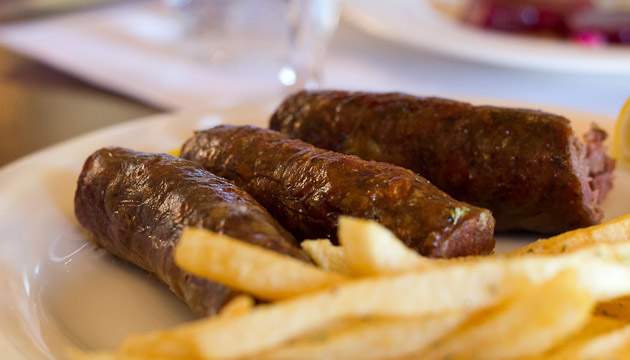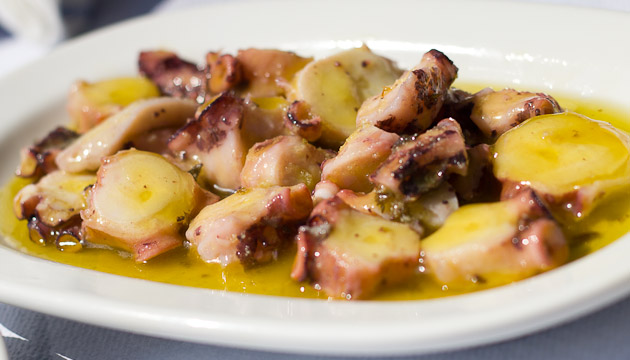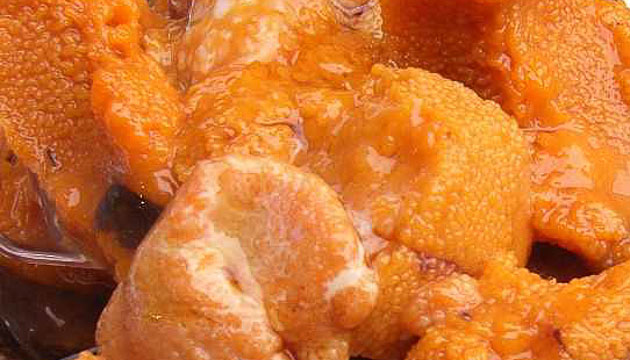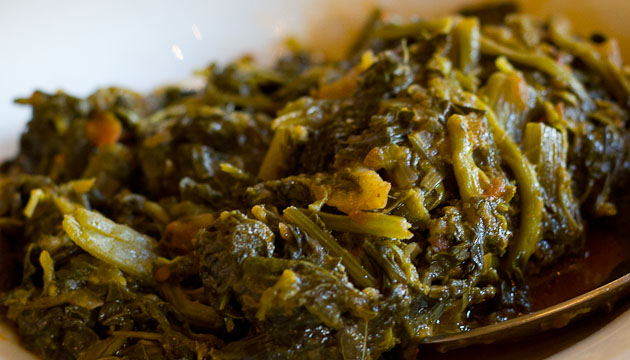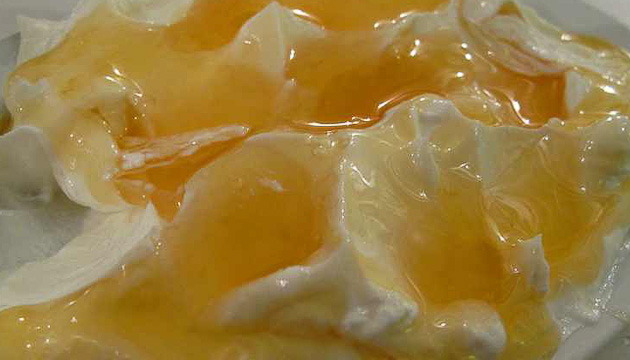20 Greek Foods You Have to Try
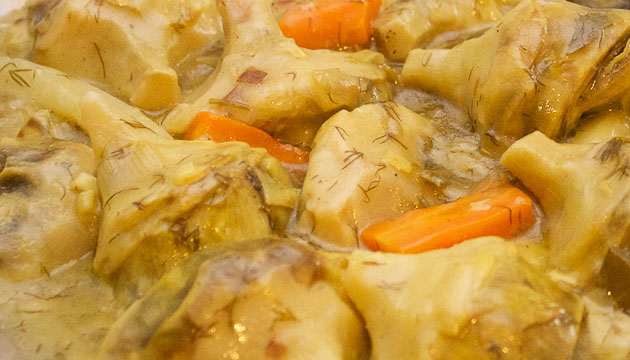
Greek food doesn’t have the world’s best reputation. Much of it falls under the shadow of Turkish food – and, at the risk of alienating every single Greek reader, that’s because the Ottoman occupation left its mark all over the Mediterranean in culinary terms, and Greece is no exception.
What Greek food does best is big, bold, earthy flavours, seafood, seasonal greens and game – places like Sto Kioupi, in Dimitsana major on this.
Greek cuisine is not fancy cooking, and it’s rarely heavily spiced, but there’s one hell of a lot more to Greek food than moussaka – and if you love garlic and good olive oil, you’ll be in heaven. So, if you’re visiting Greece next summer, here’s my top 20 Greek foods to look out for — in alphabetical order, in case you’re wondering.
Artichokes with Lemon and Dill (Aginares a la Polita)
A simple stew of succulent artichoke hearts, carrots and potatoes in a sauce of lemon and dill, this classic from Constantinople is the ultimate choice for any vegetarian visiting Greece, and phenomenally easy to make at home. Lemony, moreish and aromatic.
Baklava
While almost certainly native to Ottoman Turkey, baklava is the defining Greek sticky sweet – filo pastry, filled with honey and nuts, most often walnuts (in Turkey, pistachio is the default). Endlessly delicious, particularly with thick, dark Greek coffee.
Fried Squid (Kalamari)
Put all those thoughts of packaged squid rings out of your head – and check before ordering that the squid comes fresh, not from a plastic bag in the freezer. True kalamari, chunks of baby squid flash-fried in a light batter and served with lemon, is a taste sensation: I like the crunch and bite of the crispy tentacles, though others prefer the softness of the body.
Giant Beans (Yiyantes)
Large, flat, white beans stewed to utter softness in a sauce of onion, garlic, tomato and olive oil. There’s something about the flouriness of the beans and the oleaginous softness of the tomato sauce that makes this earth flavour irresistible.
Greek Salad (Horiatiki Salata)
Yes, yes, it’s a cliché – but it’s a classic for a reason. Slabs of oregano-infused feta and salty, tangy olives on a bed of cucumber, tomato, perhaps some pepper, and very occasionally lettuce. Dress it yourself with wine vinegar, salt and good olive oil, and it’s perfect on a sunny day.
Hunter’s Sausages (Loukanika)
Big, earthy flavours, with a little cayenne spice, a lot of garlic, and plenty of the magic Vitamin P that’s so sadly missing from Turkish food – even better made with wild boar during the hunting season.
Kebabs (Souvlakia)
Rich chunks of fatty pork, simply basted with a tonne of oregano, a little pepper, salt and a hint of olive oil, and grilled on skewers over an open fire, are one of the classic Greek holiday dishes. Should you get bored, just switch to lamb.
Moussaka
Everyone who goes to Greece has to eat moussaka once. It’s pasta, ground beef, aubergines and bechamel, with an unctuous, creamy quality to it which will either have you salivating or – in my case – thinking it would be better with cheese.
Octopus Salad (Oktapodi Salata)
The sight of octopuses tenderising in the sun is a classic of any Greek fishing village, and Greek octopus salad is quite phenomenal. Super-tender chunks of octopus in an oil-vinegar-oregano dressing are hard not to love.
Red Mullet (Barbounia)
A fresh fish dinner at a seaside taverna is something everyone should enjoy at least once in Greece. And one definingly Greek fish to try? Red mullet, with a light flavour and melting texture that tastes like a cross between trout and sea bass. Pick the large ones, to protect fish stocks.
Retsina
An acquired taste for many, but I love this uniquely Greek white wine. It’s matured in pine casks, giving it a piney, resinous aroma and flavour that, for me, pairs perfectly with the big, earthy flavours of Greek country cooking, eaten outside in the open air.
Sea Urchins (Ahinous)
The Japanese call it uni; the Greeks, ahinous. Raw sea urchin roe is not to everyone’s taste – the Mediterranean version are far saltier, and sea-ier, than the Japanese. But if you already love raw oysters, then raw sea urchins are the natural progression.
Skordalia
If you love garlic, then skordalia, a puree of garlic and olive oil thickened with either potatoes or bread depending on the region, is to die for. I like the potato version, with tonnes of garlic, for its grainy texture and garlic overload.
Spinach Pie (Spanakopita)
Crispy filo pastry, filled with soft dark spinach and chunks of tangy, melting feta cheese. Spanakopita is easier to find sold as a small, triangular pastry, alongside tyropita, the little cheese pastries, but best as a serving from a pie made for many — you get more filling that way.
Stuffed Tomatoes (Yemista)
Thanks to hot, dry summers, Greek tomatoes have a flavour that wetter climates just can’t match. Here, they’re filled with a herbaceous rice mix that sometimes includes ground beef, and slow-roasted with plenty of olive oil until they’re sweet and unctuous.
Stuffed Vine Leaves (Dolmades)
One of the classic Greek meze, or appetisers, these are parcels of brine-pickled vine leaves around a lightly herby rice filling, with a rich green flavour and a chewiness to the vine leaves that makes them borderline addictive.
Taramasalata
Forget the lurid pink gloop you’ll find it supermarkets and tourist restaurants and look for a grey colour that indicates this classic Greek dip has been made fresh. Taramasalata should be a tangy, salty blend of grey mullet roe with a tonne of garlic and bread or potato – and the real thing is a sea sensation.
Tzatziki
Yoghurt is one of the great delights of Greek cuisine, and this classic dip, with cucumber, garlic, salt and, often, mint and or dill, makes South Asia’s raita seem, frankly, a bit dull.
Wild Greens (Horta)
It’s still not uncommon to see Greek families and older people out in the countryside picking wild greens, and when you’ve tried these stellar bitter leaves, dressed simply with olive oil and lemon, you’ll know why. The best thing? Because of the mix of leaves, pretty much every plate is different.
Yoghurt and Honey (Yiaourti mi Meli)
The sheep and goats which graze on Greece’s rugged hills make quite phenomenally tasty milk, which transforms into brilliant yoghurt. Mixed with honey that still holds the notes of the spring’s wild herbs, this is truly the breakfast of champions.
Picture credits: Artichokes by Alexander Baxevanis; Sea Urchins by SigusR0; Yoghurt & Honey by Jordan Sim.
